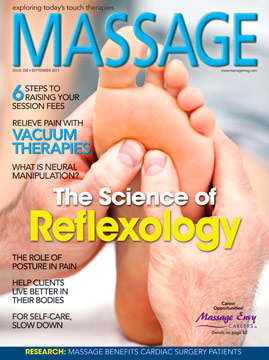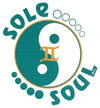"Best Buy" - San Diego Reader 11/2007 By Eve Kelly. Link

I got curious about reflexology after my sister-in-law convinced me to let a woman at a spa rub hot rocks against my feet for an hour. By the time she was finished, I felt more relaxed and refreshed than I could ever remember feeling. I wanted to know what made reflexology "work" for me. Ariel Talmor of Sole-to-Soul in East San Diego ( sole-to-soul.com ) is a reflexology practitioner and faculty member at San Diego Pacific College of Oriental Medicine. Put simply, said Talmor, reflexology is "the stimulation of pressure points and other areas in the feet that stimulate points and other areas in the body. Everything I do is a result of my own studies and observations," and those observations have taught Talmor that "the body is a microcosm of the universe. The head is connected to the universe, the air. It is the opposite of the feet, which are connected to the earth. What I try to do is open the body to energy flow. A lot of energy is flowing through us at all times, from the top of our heads to the soles of feet and into the earth. Our feet, the lowest part, are heavy. Because they touch the ground, they are the last place in the body where energy flows before it goes into the ground. So feet can hold blocked energy."
The typical client, said Talmor, "can expect a great tune-up. They will have an overall alignment of mind, body, emotions, and spirit that leaves them rejuvenated and refreshed [ $85 for first 50-minute session, $125 for subsequent sessions]." Some say they feel more clarity, more integration, or more patience. If it sounds a touch mystical, Talmor is comfortable adopting more conventional language: "Reflexology opens up circulation to places where circulation is compromised -- this has been proven with thermal photography. When you improve circulation, you allow all the organs to breathe and function better and to restore themselves. I can help with stress management, general sluggishness, and ailments like back pain and digestive problems. But I'm not just there to fix something -- my work is a nurturing experience."
Talmor doesn't call what he's doing "massage." "I'm manipulating the feet. I do thumb- or finger-walking, pushing it forward almost like a caterpillar. These movements are meant to stimulate and break crystalline formations. Sometimes, these are found with touch; other times, with intuition. Crystalline formations are the sign of a weak energy line that needs to be strengthened. The idea is that every organ that is in the body is connected through an energy line to the feet." If the organ is not functioning at maximum efficiency, "waste material, in very minute quantities, will form gently in the feet. I think that these formations are not the blockages themselves, but signs of the real blockage."
So it's not surprising that crystal crushing is not Talmor's ultimate goal. "What I do is optimize energy centers," starting with an application of the five elements of Chinese medicine. "In Chinese medicine, the five elements are metal, fire, water, earth, and wood. I've borrowed these principles and applied them to the toes as a part of advanced reflexology. We have five toes. Each toe has an energy line and represents an energy center. These represent organs, and they also go to who you are as a person. The big toe is metal, which corresponds to thinking and perception, and also with the lungs and colon. The second toe is fire -- habits and charisma and also the heart and small intestine."
Talmor was giving me the short version; for the third toe, he got a touch more expansive: "The third toe is water -- instinct, balance, and boundaries as well as the kidneys. It's also about fear. If someone was raised with a lot of fear, there will usually be a redness or abnormality -- like a corn or a bump -- on the middle toe of the left foot. [The left side is your past.] It could also be there because of kidney issues. And the kidney also corresponds to the middle of the foot," just a little further up the energy line.
We continued on to the fourth toe. "That's earth -- the emotional center and also your liver, pancreas, and spleen. It's very powerful. The fifth is wood -- creativity and the reproductive organs. If a lady is missing a toenail on her fifth toe, it could be a sign of menstrual or fertility conditions. If a person can't spread their fifth toe away from their fourth, "it's a sign that someone leads a very routine life. Sometimes, they're bored, or they feel stuck or afraid."
Determining whether blockages are brought on by conditions that are physical (fertility) or mental (boredom) is part of Talmor's tactile investigation. "I practice an openness to the impressions that come through me while I'm working. Sometimes I'm wrong, but I'd say 85 percent of the time I say things that hit home with the client."
Then East meets West: "I combine the elements of Chinese medicine with the four elements used in Western astrology -- air, fire, water, and earth. In this model, all the toes correspond to the air, which is thinking. The ball of the foot is fire -- passion and stamina. The arch is water -- emotions and flow. The heel is earth -- basic needs, your foundations. I work with the five elements and the four elements at the same time. If I work on the big toe, it corresponds to thinking from both the Chinese and Western elements. By working on the big toe, I can actually affect the way you think by opening you up to optimal energetic flow." But that's not all. "The big toe is also connected to the colon and large intestine. After two or three sessions, some clients will have a lot of bowel movements -- this helps to remove toxins from the body. Or when I work on the fourth toe, which is the emotional center, people might have excessive dreaming."
"Access Clients’ Life Cycles with Reflexology" - Massage Magazine 08/2013 By Ariel Talmor Ph.D. Link

To complement the MASSAGE Magazine article, “The Science Behind Reflexology,” by David Allan, D.C., in the September 2013 issue. Article summary: The popularity of reflexology has been on the rise for the past two decades. Reflexology is featured on the menus at thousands of spas, in addition to being practiced by trained massage therapists in private practice and certified reflexologists at medical facilities around the globe.
Foot reflexology was well known to the ancients in China and Egypt, and its benefits continue to hold true today. As a complementary therapy to massage, reflexology can contribute to a client’s well-being and grounding; it can also help with the client’s retention. In this article, I will discuss how to incorporate reflexology techniques into a massage session.
The key principle in reflexology is to work on both feet intermittently. This is because, as grounding vehicles, the feet correspond to the head, with its left and right hemispheres. The combination of left and right can be done intuitively. The rule is to always start by holding both feet. This allows for equilibrium and balancing of both sides.
After that, each foot can be worked on separately. Never spend more than two minutes on one side alone. The reason is, there exists a hidden dialogue between our left and right sides and we want to respond to it.
If you have eight minutes to work on the feet, start with holding and interacting with both feet (one to two minutes), then connect with each side for up to 90 seconds. After two to three cycles, work back on both sides simultaneously (one minute).
The human foot corresponds not only to the body, but also to embryonic evolution. For example, the small bump on the medial side of the center of the big toe corresponds to our conception. Therefore, it is this point that connects to our first life cycle.
For this reason, it draws on all life cycles, as cycles tend to repeat a pattern of sorts. The bump on the central medial big toe is the conception point and also C1. This point corresponds to our first life cycle. Anytime a client is going through a major transition, this point should be worked on, as to alleviate the charge of the process. In other words, this point, on both feet, corresponds to our core energies and is a great area to work on to restore these energies.
In a massage setting, we can use massage techniques such as fine stroking and sliding to unblock passages in the feet. These contractions always correspond to some unresolved situation in our mind or body. They will feel sensitive and dense. Alternately, some areas may feel mushy and empty. The rule of thumb is: If it is empty, fill it up. If it is full, empty it. This can be done by using clockwise, circular movements to fill in, and counter-clockwise movements to empty.
Working on the big toes, in general, will bring much needed release to the brain. Since reflexology is proven to improve circulation anywhere in the body, it can even affect hard-to-reach areas such as the brain. After working on the big toe, plantar and dorsal, we can work on the solar plexus (SP). This point is found on the bottom of the ball of the foot under our third toe. Working on this point brings quick stress release.
The spine is another great area to connect to, through the feet. After working on the big toes and the SP, now we can reach nearly all vertebrae and help improve circulation around them.
We start at the same conception point on the big toe. This is, as we saw above, the point for C1. From there, we descend on the medial side of each foot all the way to the heel. The spine represents awareness. Working on the spine in massage can be tricky, but safe on the feet. The main exception is pregnant women in their first trimester. The spine and feet represent awareness and understanding.
Working on them, along with some potential stress vortexes such as the conception point and the SP, will surely help put clients at ease and, perhaps, reach deeper into their core to make for a more profound healing experience. Keeping in mind the body has metaphysical symbolism helps to better work with it. The feet represent the way we understand ourselves, others and life in general.
Ariel Talmor, Ph.D., is a healer and holistic reflexologist in San Diego, California, as well as a faculty member at Pacific College of Oriental Medicine (www.pacificcollege.edu). His new book, Sole to Soul: How to Love and Heal, encompasses his philosophy that the feet are a major tool to improve understanding and healing. His specialty is trauma and major life transitions. |

